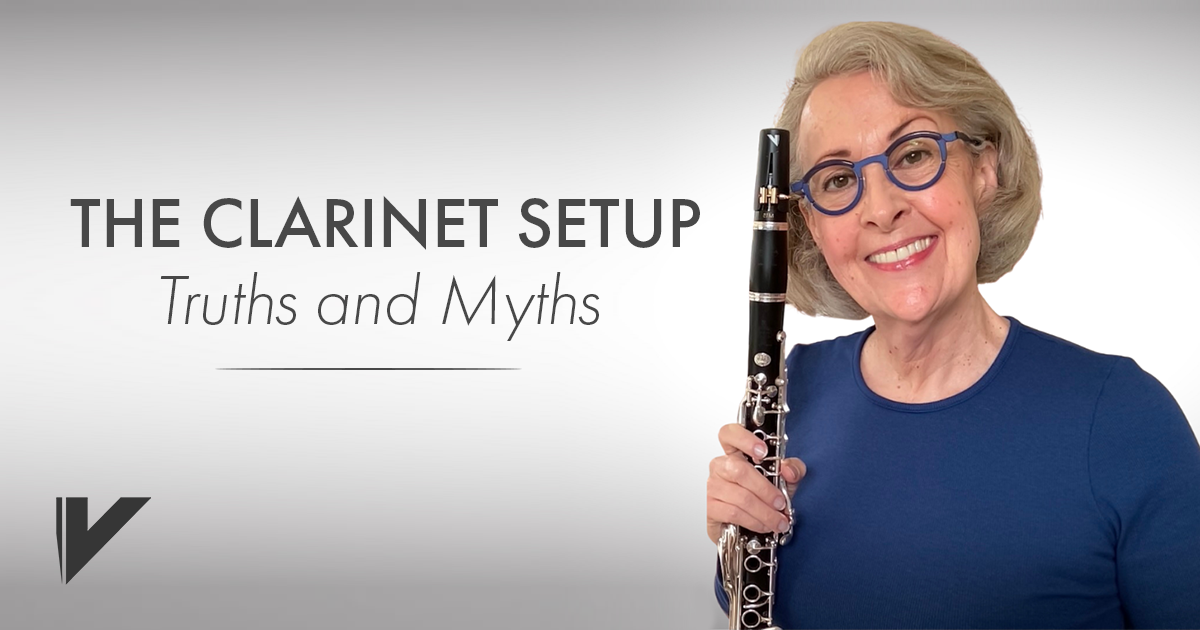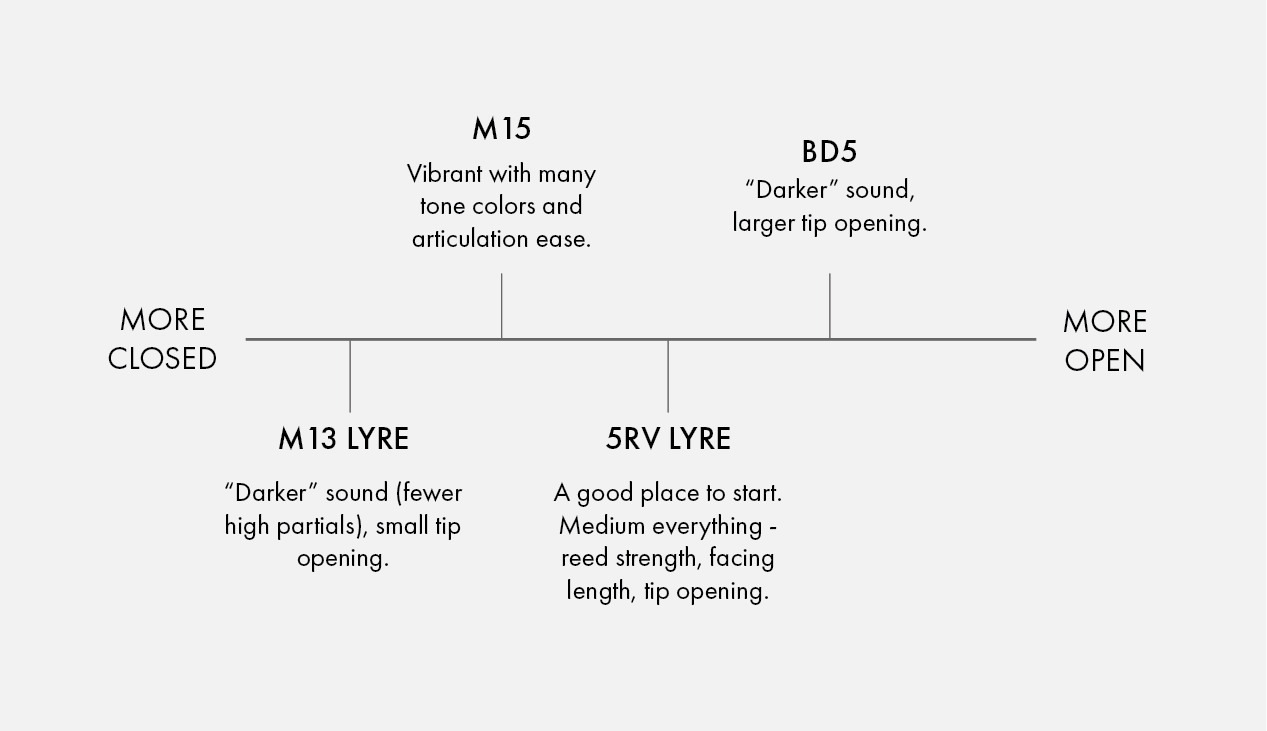How To Set Up A Clarinet
The Clarinet Setup: Truths and Myths
by Paula Corley

If you accept your students play on "this" mouthpiece and reed, they volition all sound like [insert famous clarinetist name here.]
Not all mouths are the same size and shape. One mouthpiece blueprint does not fit all. While the mouthpiece plays a critical role, there are many other variables that contribute to tone quality. The reed, airspeed, embouchure, tongue position, and instrument angle combine to create the sound.
A student's concept of sound is shaped by listening. What sound models were the students exposed to equally beginners? Did they take access to frequent sound modeling, either live or recorded? The sounds modeled for students in the early stages will be reflected in their tonal concepts.
If you have your entire section play on the same mouthpiece and reed, they volition all audio the same and play in tune together.
Not necessarily. Every bit described above, many factors contribute to an individual's sound. An excellent mouthpiece can facilitate good focus and tuning. All the same, the quality of the instrument – it's diameter design and tone hole placements for example, also play a key function in tuning.
The Clarinet is the to the lowest degree flexible instrument for tuning in the woodwind department.
While some would disagree, this statement is true, especially for developing players in an ensemble setting.
When making decisions about mouthpieces, always consider the uniqueness of the clarinet department. Flutes, double reeds, and saxophones all have more embouchure flexibility than clarinet. A low tongue position, loosened embouchure, and dropped jaw on clarinet will lower the pitch but eliminate focus. Consider buying both the A=440 and A=442 of your preferred mouthpiece (if available) to match pitch without sacrificing skilful tone quality. Rotate mouthpieces merely as you lot do with reeds.
Changing a clarinet barrel often makes a drastic difference in sound and tuning of the clarinet. This tin exist good or bad (and expensive). Frazzle the possibilities with mouthpieces and reeds earlier making changes in the barrel.
"When making decisions virtually mouthpieces, always consider the uniqueness of the clarinet section." - Paula Corley
Reeds never vesture out if taken care of properly.
Mayhap. I once heard the great Karl Leister say he played the same two or three reeds for an entire year because the war in his state eliminated his access to buying replacements. Some players play and rotate reeds for months and even years.
The key here is "if taken care of properly." As a natural element, reed cane will weaken over time with prolonged utilise. Saliva contains enzymes that break down nutrient so it's reasonable to assume these same enzymes will break downwardly the reed over fourth dimension. Use clean h2o to moisten and store reeds in a good reed case to increase longevity. Rotation is important.
Mouthpieces never wear out.
It's possible to use a mouthpiece for many years.
All the same, if you are experiencing squeaks and have eliminated all the other variables with your instrument and reed, wait at your mouthpiece with a magnifier.
The reed vibrates intensely for long periods of time against the mouthpiece rails. Mouthpiece runway may go uneven or develop minute abrasions that tin cause response problems. Some issues can exist corrected past an adept mouthpiece repair person. Rotating between primary and back-up mouthpieces will increase longevity.

Ligatures aren't that of import.
Yes, they are. Metals take slightly different weights. Weight affects how the reed responds. The M|O ligatures in 4 dissimilar metals are excellent examples of how audio tin can be changed with the same mouthpiece and reed. Ligatures come in many different designs and materials and are a matter of personal preference. The ligature is an important office of the "set-up". Don't disbelieve its' importance.

Paula Corley is the Didactics Counselor for Buffet Crampon North America. She has 33+ years of teaching experience from eye school to university level. Most recently Paula served as the clarinet teacher at Texas Lutheran University where she hosted 'clariNETWORKS' – a very popular almanac issue for clarinetists of all ages and band directors. She is also a chamber music judge for Music for All's National Bedchamber Music Festival and served as the Pedagogy Chair for the International Clarinet Association from 2022-2020. Most know her as the 'mayor' of Clarinet Urban center, a educational activity website for all ages and stages of clarinet playing.
Originally from Mississippi, Paula grew up without access to clarinet lessons which sparked a lifelong interest in research for developing players. She is a graduate of Mississippi Country University (BME) where she was named Alumnus of the Twelvemonth in 2022-13 and Southern Methodist University (MM) where she worked with the legendary Howard Dunn. Paula taught in Plano, Texas ISD for many years earlier moving to Asheville, NC where she served as primary clarinet in the Asheville Lyric Opera and on the faculty at Mars Hill Academy (NC).
Author of So You lot Want to Play the Clarinet and The Break (Southern/Hal Leonard), Paula has performed and presented at music conferences throughout the US since 1998. She is a performing artist and clinician for Vandoren and for Cafe Crampon and her manufactures have appeared in THE CLARINET, Vandoren WAVE, The Texas Bandmasters Review, and The Instrumentalist. A new series of her arrangements for clarinet can exist institute at Hal Leonard. (Run into the Homepage for links.). She also has 2 recorded works for clarinet: Unfamiliar Territory past Michael Markowski and Road Trip for clarinet quintet by Clifton Jones.
Source: https://www.dansr.com/vandoren/resources/the-clarinet-setup-truths-and-myths

0 Response to "How To Set Up A Clarinet"
Post a Comment